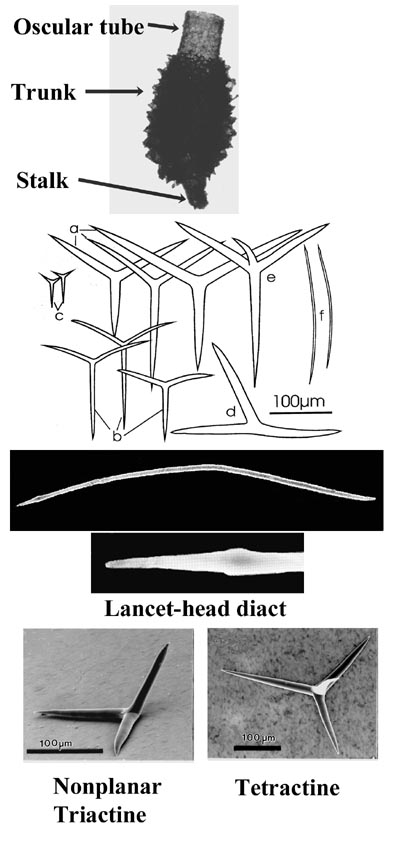[A]
Body clearly tripartite, consisting of oscular tube, trunk, and stalk.
Found at depths of > 1000 m. |

| | Sycon escanabensis
Duplessis & Reiswig, 2000 |
Sponge:
Tripartite, with oscular tube, trunk and stalk. Total length of body 3.4-5.6 mm.; width: 2.4-2.6 mm. Oscular tube length: 0.9-1.2 mm; diameter 0.9-1.1 mm. Thin lancet-head diactines project from margin. Trunk conulose and hispid: length 1.8-3.6 mm. Cones ornamented with small lancet-head diactins. Stalk tapered. Length: 0.90-0.95.
Spicules: Megascleres:
(1) Lancet-headed diactins:
73 - 341 um.
x 1.4 - 5.1 um.
(2) Saggital triactins: Large medium and small-ray length:
28 - 559 um.
x 5.6 - 47.9 um.
(3) Irregular (nonplanar) triactins-ray length:
28 - 559 um.
x 18.5.6 - 47.9 um.
thick (4) Tetractins -primary rays as in saggital triactins (Atrial ray lengths):
93 - 228 um.
Skeleton:
Oscular tube lacks choanocytes. Well-ordered skeleton of saggital triactins.Thin lancet-head diacts form marginal oscular fringe and the external surface of the tube. The trunk contains choanocytes in coalescent chambers.
Tetractins are common at the intersection of the flagellated chambers and atrial cavity. The basal stalk lacks choanocytes, an axial cavity, and external diactin ornamentation.
Distribution: North Pacific Basin; Escanaba Trough, Gorda Ridge, Northern California.
Depth: 3500 m.
|
|
|